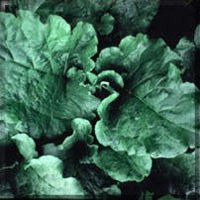
Arctium lappa

Arctium lappa
Desription - The root of burdock has been used in its native haunts, which include much of Africa and Europe, to improve immunity and overall health for at least 3,000 years. Like the honeybee, it has followed civilization. The plant produces a burr that gets stuck on people’s clothing, and in this manner it has been carried to every continent. In recent years, the burdock has come to be considered a weed, despised by lawn owners for its tenacious growth habits. The plant is a biennial, which means that in its second year it blooms and then dies. Burdock spends its first year of life working industriously to store all the necessary elements to bloom the following year. The part of the plant we use in clearing the skin is the root. All the richness of the plant is safely packed away in the long, tapered root just as the leaves start to fall, and that's the time to pluck it from the ground, in the autumn of the plant’s first year.
Therapeutic Uses - Burdock has the ability to gently stimulate health and, as a consequence, to improve the appearance of the skin. Elements contained in the plant improve the digestion and absorption of food, which makes the body stronger and better able to fight infection. Furthermore, one of the powers attributed to burdock is its ability to cleanse the body. In days gone by, it was considered a blood cleanser and offers a stimulating effect on the excretory systems, helping to rid the body of toxins.
Pharmacology - The root contains lignans including arctigenin, glycoside arctiin and matairesinol; polyacetylenes including tridecadienetetraynes, tridecatrienetriynes and a sulphur-containing arctic acid. It also contains amino acids including alpha guanidino-n-butyric acid, inulin, organic acids, fatty acids, and phenolic acids.
Medicinal use - Like many of the members of the daisy family – chamomile, elecampane and calendula included – burdock has the specific ability to speed the healing of the skin. Psoriasis, dandruff, wounds, ulcers, eczema, eruptions on the skin, boils, carbuncles, sties, sores, aphthous ulcerations and chronic acne are all treated effectively with burdock. Where calendula is used externally to improve the skin’s appearance, burdock is taken internally.
In China Burdock is used as a anti-inflammatory, antipyretic, diuretic, antitumor, antifungal, estrogenic, hypoglycemic and antibacterial. The 1917 booklet entitled Health from Field and Forest reiterates this idea of burdock as a cleansing plant: "The root is one of the best blood purifiers, used in scorbutic, syphilitic, scrofulous and leprous diseases, eliminating very rapidly any impurity or poison from the blood. It is also very useful in gout. The leaves form a cooling and healing poultice for boils, carbuncles, etc., and the seeds are excellent for dropsy and kidney trouble, and are also an effective remedy for neuralgia." At the time the booklet was written, all forms of skin conditions were treated with burdock, even leprosy!